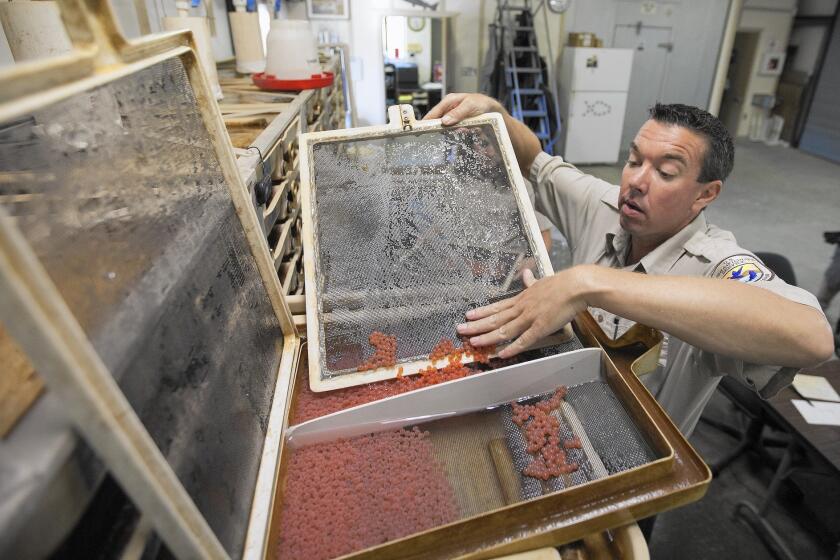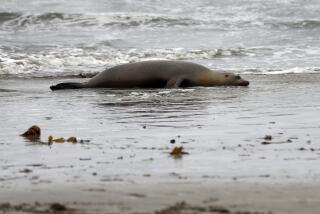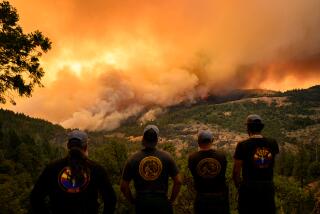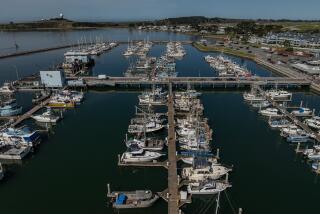Something was killing baby salmon. Scientists traced it to a food-web mystery
- Share via
The biologists working in a fish hatchery near Shasta Dam grew increasingly concerned last year when newly hatched salmon fry began to act strangely — swimming around and around, in tight, corkscrewing motions, before spiraling to their deaths at the bottom of the tanks.
Certain runs of chinook salmon in California are imperiled; the hatcheries and the fry raised there are the federal government’s last-ditch effort to sustain these ecologically and economically vital fish populations.
So, when scientists observed the young salmon’s screwball behavior, they reached out to their networks in oceanography, ecology and fisheries: Had anyone seen anything similar? Did anybody know what was going on?
As it happened, scientists and hatchery managers around the Great Lakes had observed similar abnormalities in lake trout, beginning in the 1960s. Although it took a few decades, scientists eventually unlocked part of the mystery: The fish had a deficiency of thiamine, or vitamin B1.
Thiamine is essential among living things for critical metabolic processes, such as energy production and nervous system functioning. Humans and animals acquire the vitamin through food, or in the case of modern humans, supplements. It is created by certain plants, phytoplankton, bacteria and fungi.
People, plants and animals can’t live without it.
The essential nutrient was first identified in the early 1900s by a Dutch physician, Christiaan Eijkman, who noted a similarity between the human disease beriberi and a similarly debilitating syndrome in chickens. He was awarded the Nobel Prize for his discovery in 1929.
Soon after, thiamine deficiencies were identified as the cause of scores of die-offs in domesticated animals, such as sheep, cattle, mink and goats. It became standard practice for veterinarians to prescribe the vitamin to livestock.
Beriberi in humans was also linked to thiamine deficiency. Symptoms include weight loss, emotional disturbances, impaired sensory perception, weakness and pain in the limbs, and irregular heartbeats. It is a risk factor for alcoholics and those who eat diets composed of primarily white rice.
It’s also an affliction that researchers say may be appearing more frequently among wild populations of animals — including fish, mussels, birds, moose and wolves.
In the case of the California salmon, federal scientists and hatchery workers decided to see if their hunch was correct.
U.S. Fish and Wildlife Service employees bathed the young fry in vitamin-enriched water.
The fish started acting normal.
“The great thing about hatcheries is they provide an opportunity” to observe broader issues that may be playing out on the salmon life cycle, said Rachel Johnson, a fisheries biologist with the National Oceanic and Atmospheric Administration and UC Davis. It allowed the researchers to recognize a deficiency that is likely affecting wild populations, too.
Johnson, who came to the project after the deficiency had been identified, then worked to take the experiment one step further. She and her team pulled 60 adult winter run female salmon and treated half with thiamine, the other half with a placebo. The eggs and fry from the treated females thrived. About half of those from the placebo group didn’t.
“This suggests that a significant portion of the wild winter run spawning in the river may have been significantly impacted by thiamine deficiency,” she said.
California’s winter run chinook are federally listed as endangered, the spring run is threatened, and the fall and late fall runs are the dominant source to the commercial fishery. The names refer to when the four subpopulations make their migrations to high-elevation spawning waters, nearly all of which were blocked by dams, decades ago.
The next question was the cause of the vitamin deficiency.
Last summer, a narrow, rock-rimmed stretch of the Sacramento River near here turned into a mass graveyard for baby salmon.
In the case of the fish in the Great Lakes, stomach content analyses showed that lake trout and salmon had been feeding heavily on alewives, which contain an enzyme known as thiaminase that breaks down thiamine.
In 2019 and 2020, reports from commercial anglers off the Central California coast, as well as from bird biologists at the Farallon Islands and Año Nuevo Island, indicated an unusually large anchovy presence in the waters.
Nate Mantua, a fisheries researcher with NOAA in Santa Cruz, found that the salmon were gorging on the small, silvery fish by examining the stomach contents of some local, commercially harvested salmon.
Anchovies, like alewives, he said, are rich in thiaminase.
Combine the observations of funny acting fry, anchovy-filled stomachs, and thiamine supplements that seem to work, and it seemed the culprit had been found.
But Mantua and others think there may be more to the story than a simple, isolated vitamin deficiency.
“We’re looking at a big ecosystem disruption,” said Clifford Kraft, a professor of environmental science at Cornell University. “All of these anchovies in this unusual band along the coast, it’s a sign that things are changing.”
And not just the climate, he said.
He referred to the work of Lennart Balk, an environmental biochemist at Stockholm University, in Sweden, who has been documenting thiamine deficiencies in a range of species around the Baltic Sea and elsewhere for decades. His work has caught the attention of other scientists, including the editorial staff of the peer-reviewed journal Trends in Ecology and Evolution, which in 2018 labeled worldwide thiamine deficiencies “as a possible driver of wildlife population declines” and called it an “emerging” issue.
“I think it’s been going on for a number of decades,” said Balk, who noted that more than 75% of egg-laying bird species he investigated around the Baltic Sea, in 2009, were suffering from a deficiency.
“We are witnessing mass extinctions at a global scale,” he said. “This could be connected. This could be very important.”
While Balk thinks thiamine deficiencies could be caused by industrial or pharmaceutical agents and Kraft wonders if sewage outflow of transformed thiamine could be disrupting the availability of the vitamin, others are calling on the scientific world to first gather baseline data on B1 levels in the environment.
“We don’t know what’s normal,” said Kraft.
“And that’s where it gets a little murky,” said Kraft. “Is this an emerging problem? Or is it our perception of it as an issue that is emerging?”
But it’s caught the attention of Mantua, who is now reading the work of scientists such as Balk and Kraft, as well as collaborating with researchers, such as Don Tillitt — a toxicologist at the U.S. Geological Survey in Missouri, who helped identify the connection between thiamine and lake trout in the Great Lakes.
Tillitt has called for more research, noting, like Kraft and Mantua, that we can’t know if something is a problem until we understand what is normal.
Mantua says he feel like he and other researchers are embarking on a new paradigm for studying and understanding ecological systems around the globe.
“This has pulled me in different directions and ideas I’d never thought about,” he said. “We’re now at that point of how do we uncover this story? It’s really intimidating and exciting.”
As for the California salmon, scientists are now waiting to see if the fry that received the thiamine treatments develop and reproduce normally, or whether their offspring are damaged irreparably. As for the wild salmon along the coast, the researchers can only wait and hope.








